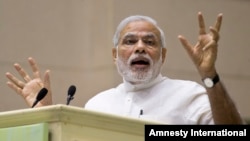When Indian Prime Minister Narendra Modi heads to China for a three-day visit starting Thursday, the focus of the visit will be on bolstering economic ties, rather than the long-standing regional rivalry between the Asian giants.
Modi will be the first Indian leader to visit China within a year of taking office.
Srikanth Kondapalli, a professor of Chinese Studies at New Delhi’s Jawaharlal Nehru University, said that fact is driven by the high priority Modi is placing on encouraging Chinese investment for manufacturing and infrastructure projects in India.
“Prime Minister has made ‘Make in India’ as his flagship program. Prime Minister Modi realizes that since China has huge foreign exchange reserves, some of these could be utilized in terms of investment in India. Specially the manufacturing sector is one of the key areas of attraction for India, in which China has made major strides,” Kondapalli said.
Modi will meet Chinese President Xi Jinping in the ancient city of Xian Thursday before travelling to Beijing for a formal welcome and then on to Shanghai.
Investments
The two countries are expected to sign deals worth about $10 billion, which could include Chinese investments for high speed rail links and industrial parks in India.
Besides investment, India will also push for greater access to the Chinese market. Two-day trade topped $70 billion last year, but India’s deficit stood close to $38 billion.
Indian Foreign Secretary Subrahmanyam Jaishankar outlined ways in which New Delhi could address this.
“On the trade side, we think it is completely conceivable that China imports more from India. There are many areas where India is globally competitive, but somehow we have not been able to be successful in the Chinese market. Two very often cited examples are Indian pharmaceuticals or Indian IT enabled services,” Jaishankar said.
The efforts to deepen economic engagement are being made despite a festering border dispute in the high Himalayas that has defied a solution for decades and a simmering regional rivalry that is prompting new partnerships.
Under Modi, who has spearheaded a more assertive foreign policy, New Delhi has enhanced strategic alliances with the United States and Japan. China on the other hand is bolstering ties with India’s rival, Pakistan, with President Xi announcing a $46 billion dollar investment program during a visit to Islamabad last month.
Economic corridor
This includes a proposed economic corridor that raised hackles in New Delhi because it will run through Kashmir, the region disputed between India and Pakistan.
Foreign Secretary Jaishankar said India has already raised the issue with Beijing. The issue is also likely to figure in the bilateral talks.
However, China expert and former member of India’s National Security Advisory Board Jayadeva Ranade in New Delhi said that despite the absence of trust between the Asian giants, both sides primarily want to take advantage of each other's large economies.
“There are underlying tensions which neither side will ignore. At the same time the primary objective will be to see if we can keep cordial relations and try and engage economically wherever possible. He (Modi) will try and look for economic opportunities because that is his main agenda,” Jaishankar said.
Analysts expect little headway on the contentious border issue, but say both countries are likely to emphasize the need to maintain tranquility.
Last year saw tensions spike on the border when the Chinese president visited India. However, Modi said in a recent interview with Time magazine that the two countries have shown "great maturity" in recent decades over the issue.
Where relationship is headed
Analysts like Kondapalli think both sides will use the visit to explore where the relationship is headed. He said while India could use Chinese investments, Beijing cannot ignore that India is set to become the world’s fastest-growing economy.
“It will also be in terms of gauging each others perception and how each there could position themselves. China is also noticing that Indian growth rates are becoming higher, so I think China is also cautiously approaching India in this background. While China may not heavily invest in India, yet they also have to consider the market-related benefits,” Kondapalli said.
From China, Modi will head to Mongolia and then to South Korea, where the Indian leader will also seek investment possibilities, which he considers critical to steer India on a high-growth trajectory.




